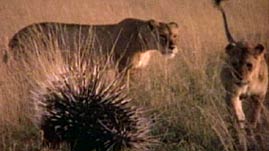Teachers' Domain - Digital Media for the Classroom and Professional Development
User: Preview

Source: Produced for Teachers' Domain
Animal Defenses (Audio Description) (Video)
NARRATOR: How does an animal protect itself from becoming another animal's dinner? This hognose snake is harmless, so how does it defend itself against a curious kitten?
First, the snake tries to look dangerous. When looking dangerous doesn't work, it tries defense number two—looking dead. If needed, the snake has a third defense...giving off an awful smell. Finally, the kitten has had enough.
This puffer fish seems like easy prey for this otter. But not really. This fish can blow itself up like a balloon. Not only is it too large for the otter to grab or bite, but the fish also raises thousands of tiny prickles. Discouraged, the otter leaves. Left alone, the fish shrinks back to its normal size.
This time, the sea otter is looking for a meal in the ocean. But this feisty crab, poking its claws at the otter, holds its own.
These lions are checking out whether this porcupine might make a good meal. To protect itself, the porcupine has about 30,000 quills, which are as sharp as fishhooks. The porcupine takes advantage of this opening to scamper off.
The word "rhinoceros" means horn-nosed, and the horns of a rhinoceros are about 2 1/2 feet long--long enough for the rhino...(rhino snorts) to defend itself and its young from lions, tigers and hyenas.
This squid may not seem like much of a match for this barracuda. The squid squirts ink and escapes through the dark cloud. Do you have an idea how this turtle protects itself?
 Loading Standards
Loading Standards Teachers' Domain is proud to be a Pathways portal to the National Science Digital Library.
Teachers' Domain is proud to be a Pathways portal to the National Science Digital Library.
